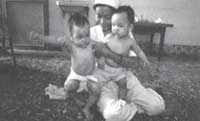A generation scarred
 EVEN after 23 years, the Vietnam War continues to invade the lives of the soldiers who waged the war. Only now there is no distinction of race or colour. Both US and Vietnamese soldiers are suffering because of a chemical, Agent Orange, sprayed in Vietnam by the US from 1961 to 1971.
EVEN after 23 years, the Vietnam War continues to invade the lives of the soldiers who waged the war. Only now there is no distinction of race or colour. Both US and Vietnamese soldiers are suffering because of a chemical, Agent Orange, sprayed in Vietnam by the US from 1961 to 1971.
Agent Orange is the name given to a mixture of herbicides, rich in dioxins (hormone disrupters). It is a code name for the orange marker that was used to mark the drums it was stored in. The purpose of the product was to deny forest cover and concealment in dense terrain by defoliating trees and shrubbery where the enemy could hide.
The US had sprayed close to 44 million litres of the herbicide over six million acres in Vietnam during the wartime operation code-named Operation Ranch Hand. Nearly 8.5 per cent of south Vietnam was sprayed atleast once. The result is that 14 per cent of south Vietnam's forests were wiped out. It's use was eventually discontinued in 1971.
One in every 100 infants at Tu Du Hospital in Ho Chi Minh City are born without arms and legs, with webbed digits or club-feet. They are all children of people exposed to Agent Orange during the war. The Vietnamese government says some Agent Orange has given the nation some 50,000 deformed children and has claimed between 100,000 and a million victims. In the US, thousands of former soldiers are demanding compensation from the US government.They claim exposure to Agent Orange has caused them to suffer numerous ill health effects, including cancer.
According to a Canadian consultancy company, Hatfield Consultants Ltd, the chemical continues to affect the people through the food chain. After a five-year study, which ranged from satellite imagery to soil sampling, the company concluded that level of dioxins in the blood of Vietnamese born after the war was frighteningly high. This indicated that the contaminants are still active in the food chain. Even in fish and animal tissue the level of dioxins was found to be very high.
The link between Agent Orange and the reports of cancer and other health problems in people exposed to it has also been confirmed by the Institute of Medicine, USA. The report confirms the earlier finding that there is sufficient evidence of a link to soft tissue sarcoma, non-Hodgkin's lymphoma, Hodgkin's disease, and chloracne. It also says there is new "suggestive" evidence to show an association between neurological disorders in people exposed to Agent Orange and con- genital birth defect spina bifida in their children.
Doctors at the Tu Du Hospital say that cases of congenital defects are higher in areas where the chemical was sprayed. In Ben Tre province in south Vietnam, for instance, it is five times higher than in Ho Chi Minh City. Tu Du Hospital is the largest hospital in the country. But with no money to invest in research facilities, the hospital is only concentrating on treating its patients. The test to establish the level of dioxin in the blood of a patients costs us $2,000 per head, which the country can ill-afford. "We have to just care for them till they die," says Le Diem Huong, head of the neonatal department.
However, Vietnam has never asked for compensation from the US. It has only sought international help in reclaiming denuded forest lands and aid for the thousands of people suffering from the exposure. There is just one question which the victims are asking themselves now: will a third generation also fall prey to the chemical?
